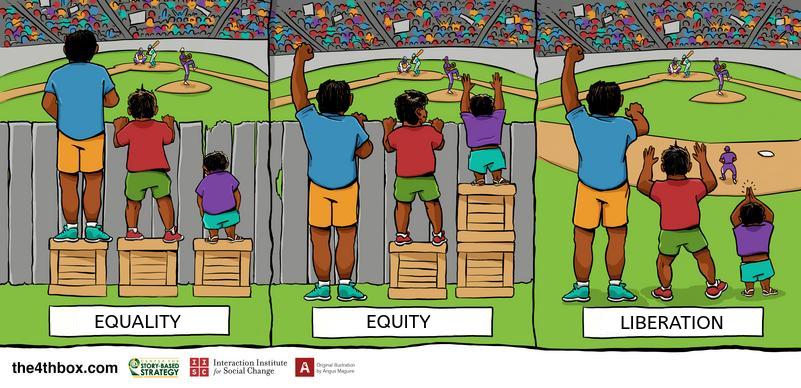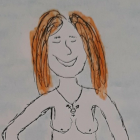Gender Justice - Beyond Equality
Institutional feminism, at least in Spain, continues to talk mainly about gender equality, understood as equality between men and women. However, there are inherent problems in the concept of gender equality, as well as problems with the reduction to two genders that coincide with two sexes.
From feminist movements, especially from the Global South or intersectional feminism, the concept of gender justice is being proposed, which goes beyond equality and tries to include what is left out of equality.
Gender equality refers to the fact that all people, regardless of their gender, should have equal rights, opportunities and treatment. It is the principle that women and men should be treated equally and have equal access to resources, opportunities and benefits in society. What is left out are the structural differences, or, in Johan Galtung's words, the direct, structural and cultural violences in our cisheteropatriarchal society, which mean that many non-men (cis and trans women, non-binary or gender non-conforming people, ancestral gender identities) do not have access to those resources, opportunities or benefits, even though there are (in theory) no legal obstacles (which is not the case for migrants in irregular administrative status).
Angus Maguire's well-known illustration demonstrates the difference. At first glance, Maguire's illustration Equity/Equality presents a powerful juxtaposition of three individuals (unfortunately, all three with a more masculine gender expression) of different heights standing on boxes, each striving to watch a baseball game over a fence. The three boxes symbolise the concepts of fairness and equality, while the individuals represent various groups in society. The fence represents the barriers and obstacles that prevent individuals from fully participating and benefiting from society's resources.

Interaction Institute for Social Change | Artist: Angus Maguire. Center for Story Based Strategy: The 4th Box
On the left of the illustration, the size of the box represents the principle of equality. ‘All three of you get the same box and are therefore equal’. Giving a box of identical size suggests that everyone receives the same resources or opportunities.
However, the fence remains a major obstacle for the lowest individual, whose view remains obstructed despite the box (or ‘equal opportunity’). This highlights the inherent limitations of a purely egalitarian distribution, as it does not address underlying disparities or the unique needs of individuals or communities.
In contrast, the centre of the illustration represents equity. In this case, the boxes are adjusted to the different heights of the people. By providing support tailored to their specific needs, the illustration demonstrates how the concept of equity enables each person to overcome the barrier and enjoy an unobstructed view of the game.
This concept of equity recognises and actively addresses systemic inequalities, ensuring that all people have equal access to opportunities, resources and support.
On the right of the illustration, the fence is completely removed, allowing everyone to enjoy the game without barriers. This powerful image underscores the importance of dismantling structural and social barriers that disproportionately affect marginalised communities.
(adapted from: Hrezek, Dissecting the famous equity/equality illustration by Angus Maguire, 14 June 2023)
Even gender equity does not change the cisheteropatriarchal framework. By providing the necessary boxes to be able to look over the fence, the valley still exists, the framework remains the same. In the context of gender, this means that in a patriarchal society non-men can be ‘successful’ if they adapt to the masculine, patriarchal framework. Margaret Thatcher as Prime Minister of the United Kingdom, Ursula von der Leyen as President of the European Commission, Kristalina Georgieva as Managing Director of the International Monetary Fund or Christine Lagarde as President of the European Central Bank got to their positions not by having made a feminist (economic) policy, putting care at the centre, but by moving well in a patriarchal world and playing the game of power, domination and exclusion well. Equality and equity do not change the basis on which our cisheteropatriarchal, colonial, ableist and capitalist society is built.
The concept of gender justice is based on liberation: it addresses systemic inequalities and aims to dismantle structural and social barriers - structural and cultural violences, in Galtung's words. It is less interested in debates about ‘glass ceilings’, so that privileged women can access positions of power (and structural violence), but more in the ‘ bottom wages’ of women and other marginalised gender identities - racialised, disabled, or with other intersectionalities.
According to the environmental NGO Friends of the Earth International, ‘Gender justice refers to a world in which everyone enjoys autonomy, freedom and equality, and can share equally in the distribution of power, knowledge and resources. Achieving this means recognising the history of injustice, oppression and subjugation faced by women as a social group.
The purpose of action for gender justice is to support women's autonomy and collective decision-making with respect to their lives, bodies and work, and to actively promote justice in all its dimensions. Gender justice also includes actions to support the struggles and claims of all gender identities, including transgender people.
As we reflect on how to make the transition to a society with equal relations between people, we identify concrete actions and activities that promote gender justice as central to this process.’
Gender justice understands that women are not a homogenous group. There are many differences between an educated white woman with a comfortable and well-paid job and a migrant woman in an irregular administrative situation with two children who has to make a living outside the official labour market or a trans woman.
Gender justice understands that patriarchal oppression of women and other gender identities (trans, queer, non-binary) or non-normative sexualities is closely intertwined with other oppressions: capitalism and class oppression, racism, neo-colonialism, heteronormativity or ableism, among others. Therefore, gender justice does not seek equality or equity within the cisheterosexual capitalist system, but seeks to transform the system, to ‘dismantle’ patriarchy and build a more just world.
If we understand the (binary) gender system with Alex Iantaffi as a collective and historical trauma that affects all gender identities (men, women, trans people), although not in the same way, we have to think also about reparation and healing the collective and social trauma.
Literature:
- Friends of the Earth International, Why Gender Justice and Dismantling Patriarchy?, 2 December 2020
- Concepto, Equidad de género, 10 December 2024
- Johan Galtung: Violencia cultural, March 2003
- Hrezek, Dissecting the famous equity/equality illustration by Angus Maguire, 14 June 2023
- Alex Iantaffi, Gender Trauma: Healing Cultural, Social, and Historical Gendered Trauma, 2020
